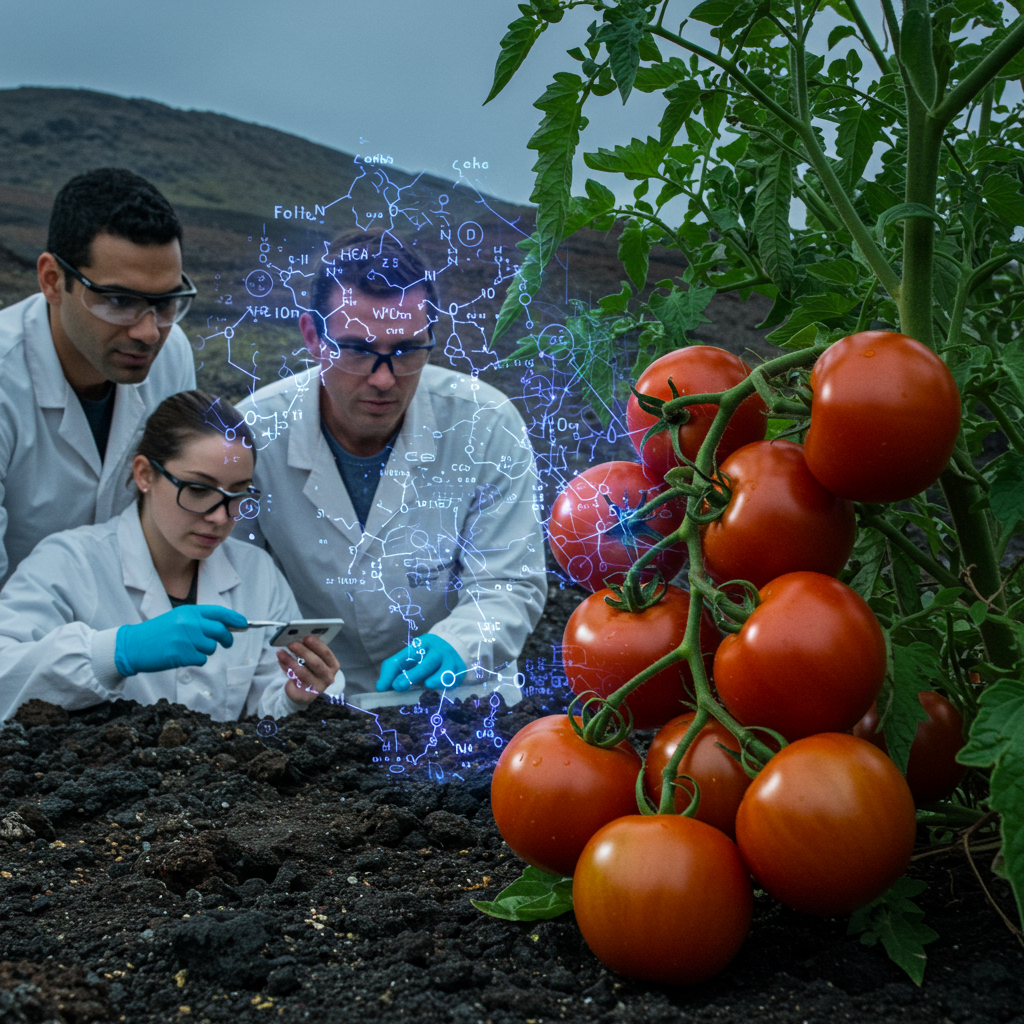In a stunning finding that challenges conventional views of how life adapts, scientists have observed wild tomatoes on the remote Galapagos islands doing something remarkable: seemingly “evolving in reverse.” This phenomenon, documented in a recent study, suggests that instead of always forging new paths, evolution can sometimes revisit and reactivate ancient genetic blueprints, rolling back millions of years of development.
The research, involving scientists from the University of California, Riverside (UC Riverside) and Israel’s Weizmann Institute of Science, provides compelling evidence that species can rewind evolutionary changes. It’s a rare, real-world example of genetic atavism propagating through entire populations in nature, rather than just appearing as isolated mutations or through laboratory manipulation.
The Galapagos Puzzle: Contrasting Landscapes, Contrasting Tomatoes
The Galapagos Archipelago is famous as the living laboratory that shaped Charles Darwin’s theory of evolution. These volcanic islands formed over millions of years, resulting in a chain with older, established islands to the east and younger, more barren landscapes still actively forming to the west. This geographical diversity provides a unique natural experiment.
Wild tomatoes, specifically species like Solanum cheesmaniae and Solanum galapagense, are native to these islands, descendants of plants originally from mainland South America. Researchers collected and analyzed dozens of samples from different locations across the archipelago.
What they discovered was striking. Tomatoes growing on the older, eastern islands produced chemical compounds similar to those found in modern, cultivated tomatoes worldwide. However, plants of the same species on the younger, western islands were synthesizing a distinctly different molecular profile.
Ancient Chemistry Reappears: The Alkaloid Anomaly
The key to this difference lies in plant defense mechanisms. Tomatoes, like many members of the nightshade family (which also includes potatoes and eggplants), produce alkaloids. These are bitter, sometimes toxic molecules that act as natural pesticides, protecting the plant from insects, fungi, and grazing animals. While the Galapagos environment might seem predator-light for animals, plants still face significant challenges.
The peculiarity isn’t just that the tomatoes are producing alkaloids, but the type of alkaloids. On the young, western islands, the tomatoes were producing an older, more ancestral form of these protective chemicals. This ancient version chemically matches compounds found in distantly related eggplant ancestors that existed millions of years ago. It was a complete reversion to a long-lost chemical signature.
This isn’t just a minor variation; it’s about the fundamental three-dimensional structure, or stereochemistry, of the molecule. The eastern island tomatoes produce the modern alkaloid stereoisomer, while the western island tomatoes produce the ancient one, despite having the same atoms.
Pinpointing the Genetic Switch: A Single Enzyme
To understand how this chemical ‘time travel’ was possible, the research team delved into the plants’ genetics and biochemistry. They focused on the enzymes responsible for assembling these alkaloid molecules.
Their investigation pinpointed a single enzyme, known as GAME8, as the critical player in this chemical pathway switch. Through meticulous analysis and modeling, they determined that an alteration in just a few amino acids—specifically, only four—within the structure of the GAME8 enzyme was enough to flip the molecule’s production from the modern form back to the ancestral one.
To validate this finding, the scientists conducted laboratory experiments. They synthesized the genes for these enzyme variants and inserted them into tobacco plants, a standard model organism in plant biology. Remarkably, these modified tobacco plants then began producing the same ancient alkaloids found in the Galapagos tomatoes. This confirmed that changes to just a handful of building blocks in this single enzyme were sufficient to effectively rewind millions of years of evolutionary history in this specific biochemical process.
Environmental Drivers: Why Revert?
The non-random geographical distribution of these chemical profiles strongly suggested an environmental influence. The eastern islands are older, featuring more developed soils and greater biodiversity. In contrast, the western islands are geologically younger, more barren, rocky, and potentially harsher, with less developed soil and different environmental stresses like varying moisture levels and nutrient availability.
Researchers hypothesize that the challenging conditions on these younger islands might be the driving force behind the plants’ reversion to ancient chemistry. Perhaps the ancestral alkaloid molecule offers a better defense against specific pests or provides superior protection in the face of the unique abiotic stresses—like drought or intense UV radiation—prevalent in this more demanding environment. Natural selection could actively favor plants capable of producing this ancient, potentially more effective, defensive compound in these specific conditions.
Using evolutionary modeling based on modern DNA, the team further confirmed that the genetic and chemical characteristics observed in the western island tomatoes align with what would be expected from their ancient ancestors. This lends significant weight to the idea that these plants are indeed utilizing a preserved ancestral genetic potential.
Broader Insights: Evolution’s Flexibility and Biotechnology Potential
This discovery holds significant implications beyond just understanding tomato chemistry. It challenges the idea of evolution as a strictly linear, forward-only march. It suggests that genomes may retain “adaptive archives,” containing the potential to reactivate long-lost traits when favored by environmental conditions. Evolution might sometimes involve re-utilizing ancestral strategies stored in the genome, rather than solely inventing novel ones. This demonstrates a fascinating flexibility in the evolutionary process.
Furthermore, understanding precisely how nature can achieve such dramatic changes in molecular output by altering just a few amino acids in a single enzyme opens exciting doors for biotechnology. This fundamental knowledge about controlling complex biochemical pathways with minimal genetic tweaks is incredibly valuable.
Scientists could potentially harness these insights for practical applications:
Developing New Medicines: Understanding how to alter molecular structures with precision could aid in synthesizing complex drug compounds.
Improving Crop Pest Resistance: Engineering plants to produce specific, highly effective natural defense chemicals, perhaps even ancient ones, could reduce the need for synthetic pesticides.
- Creating Less Toxic Produce: Conversely, this knowledge could help scientists modify plants to reduce undesirable toxic compounds, making fruits and vegetables safer or more palatable.
- www.sciencealert.com
- news.ucr.edu
- macaonews.org
- vocal.media
- www.news18.com
This study is viewed as a crucial step towards understanding nature’s elegant control over plant chemistry, which could ultimately inform sophisticated genetic engineering efforts. The wild tomatoes of the Galapagos, through their unexpected chemical step back in time, are offering a unique model for exploring the deep connection between enzyme structure, molecular function, and evolutionary adaptation, with potential benefits for agriculture and medicine.
Frequently Asked Questions
What does it mean that the Galapagos tomatoes are “evolving in reverse”?
The term “evolving in reverse” or “de-evolving” is a colloquial way to describe genetic atavism. It doesn’t mean the species is literally moving backward in time. Instead, it refers to the natural re-emergence of a lost or suppressed ancestral trait. In this case, wild tomatoes on some Galapagos islands are producing a chemical compound (an alkaloid) that was present in their ancient relatives millions of years ago but was lost in more recent lineages.
What specific genetic change caused this “reverse evolution” in tomatoes?
Researchers identified that changes in just four amino acids within a single enzyme called GAME8 were sufficient to switch the production of alkaloids from the modern form to the ancient, ancestral version. This specific enzyme is involved in the biochemical pathway that creates these defensive chemicals. Experiments confirming this were conducted by inserting the modified enzyme gene into tobacco plants.
How could understanding this process in tomatoes help science and agriculture?
The study provides valuable insights into how minimal genetic changes can dramatically alter complex biochemical pathways in plants. This knowledge is powerful for genetic engineering. It could help scientists design crops with enhanced natural pest resistance by controlling defensive chemical production, potentially create produce with reduced natural toxins, inform the development of new pharmaceutical compounds, or even engineer plants for other desirable traits more precisely.
Conclusion
The discovery among wild tomatoes in the Galapagos Islands serves as a potent reminder that evolution is a dynamic and complex process, not always following a simple, linear path. The re-emergence of ancient chemical defenses, triggered by environmental pressures on the younger islands and facilitated by minor changes in a key enzyme, highlights the surprising adaptive potential hidden within a species’ genetic history. This fascinating case of natural genetic reversion not only deepens our understanding of how life adapts but also unlocks promising avenues for future innovation in biotechnology and agriculture, demonstrating the enduring value of studying life in its natural laboratories like the unique ecosystems of the Galapagos.
Word Count Check: 1107




